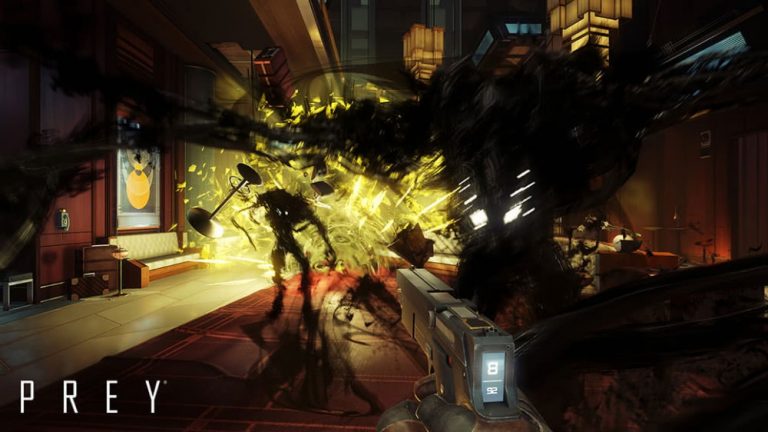With Prey releasing on Friday May 5, Game On asks the game’s lead systems designer Seth Shain about the chances of a sequel and how to get into the games industry…
The original reveal of Prey 2 was talked about for years after it had dropped off the radar. Was there any pressure to retain that original vision?
No, there was no pressure. In fact, instead of starting with the name Prey and building a game that carries forward any DNA, the opposite happened. We built the game we were excited to build, which at a high level we referred to as a “space dungeon”, and because there were some high level themes in common with the original, we adopted the name Prey.
How critical is environmental storytelling in helping to support a core narrative?
It’s critical for establishing the world within which the narrative takes place. Without little stories embedded within the world, I think the core narrative would feel hollow. For example, in a game about saving the world, you need a world worth saving before you can be motivated to save it.
A lot of detail has been placed into Prey’s world. Do you hope you’re laying down the groundwork for more games to take place within this universe?
I honestly can’t answer because I honestly don’t know. We’re still focused on shipping Prey at the highest quality level possible and we’re only just starting to discuss what comes next.
Prey and Dishonored naturally share quite similar traits, so what qualities do you believe define Arkane Studios?
My direct answer to this is that Arkane makes first person immersive simulation games. “Play your way” is core to our design philosophy. We have other values like this such as, “Say yes to the player,” [which] means that if a player expects something to behave a certain way and it doesn’t, then we have work to do.
There are an incredible number of people trying to get into game design, so what advice or experience can you share with those trying to make their mark?
Make games and get over yourself. Let me unpack that a bit. The first part is obvious – if you want to be a game designer, design games. It’s that simple. You just need to get started. The democratisation of game development has arrived. One way to go is to get involved in active mod communities for games like Skyrim and Fallout. In fact, we hired several of our level designers out of the Thief mod community. Alternatively, there are tool packages like GameMaker Studio that will let you create something entirely new with no development experience. Seriously, look how many amateur developers have crafted hit indie games with that tools suite! It may be a while before you’re leading a design team or directing a project, but that’s the result of building a career – nobody starts there.
The second part of this, “get over yourself,” is my way of saying that you need to learn to leave your ego at the door. In a healthy design culture, it is the job of the designer not to bring the best ideas, but to recognise the best ideas and shepherd these through implementation. The best ideas can come from anywhere: programmers, artists, producers, interns. The most important skill a designer can have is listening. Listen to the people around you. Listen to your players and players of other games. Experiment and recognise failure, adjust, retest and know when to move on and try something else.
Review: Guardians Of The Galaxy: The Telltale Series, Episode 1 – Tangled Up In Blue
PS4, XBO, PC
Licensed video games designed to coincide with the release of Hollywood blockbusters tend to be pretty rubbish – a fact so well known it’s almost up there with death and taxes. With Guardians Of The Galaxy Vol. 2 now hitting screens across the globe, however, Marvel has tried something a little different – entrusting its franchise to adventure game master Telltale Games. The result is Marvel’s Guardians Of The Galaxy: The Telltale Series, a five-episode tale that borrows your favourite heroes, but won’t ape their most recent quest.
As a result, the series’ debut episode, Tangled Up In Blue, may star Star-Lord, Rocket and friends, but don’t expect them to retain similar personalities (or voice actors) from the films. If you’re a Guardians fan, it’s a little disappointing to realise, but it does allow Telltale a bit of flexibility, which is made apparent in the episode’s most shocking moment, which completely departs from the MCU.

That’s not to say you won’t be indulging in enjoyable space shenanigans. Episode 1 sees the Guardians discover a powerful artefact at the start of their tale, paving the way for a new ruthless enemy to make some serious attempts at obtaining it for herself.
In typical Telltale fashion, however, pure action and spectacle will often make way for a number of interactive dialogue-heavy sequences that cover things like the potential romance between Peter and Gamora, as well as Rocket’s increasing desire to leave the team entirely. They’re not without merit, but how dramatically your choices actually influence events further down the line remains questionable.
Still, as an introductory chapter, Tangled Up In Blue does well to pique your interest, even if it doesn’t make the most of the available material. With four episodes to go, here’s hoping Telltale can power up its thrusters and make this an adventure worth remembering.


































